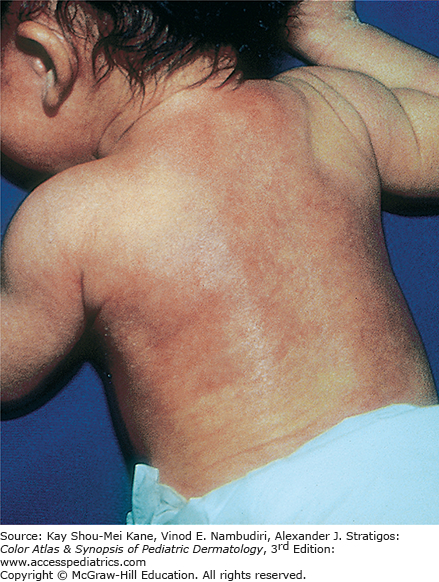Dermatology Question of the Week: Pediatric Problems

Question:
You are consulted to evaluate the following lesions on a newborn infant.

Which of the following monitoring (if any) is recommended?
Answers:
A. No monitoring is required
B. Monitor temperature and blood pressure
C. Monitor potassium
D. Monitor calcium
E. Monitor thyroid hormone
Rationale:
Subcutaneous fat necrosis (SCFN) typically occurs in healthy newborn infants and presents as purple or red plaques/nodules typically found on the back, thighs, cheeks, or shoulders and can present either at birth or within the first month of life. It is thought to be related to ischemia, cold injury, delivery trauma, or asphyxia leading to crystallization and subsequent necrosis of the fat. On histology, needle-shaped clefts, granulomatous inflammation, and calcification may be seen. Typically, patients are asymptomatic and otherwise well. This condition is self-limited and tends to resolve over a period of several weeks. As the lesions resolve, hypercalcemia may develop and prompt attention should be taken to lower the calcium level to prevent arrhythmias, seizures, and renal failure.
Correct answer: D
Hypercalcemia may occur as the lesions in SCFN resolve or even after their resolution. Although many sources recommend checking calcium levels up to 6 months of age, a recent systematic review showed that 77% of infants with SCFN who developed hypercalcemia did so within 30 days and 95% within 60 days. For this reason, it is important to check the calcium level at baseline and regularly throughout the first few months of life. Those with symptoms or slight elevations in calcium levels should be checked more regularly. Patients with hypercalcemia are frequently treated with a combination of a diuretic and corticosteroid to help normalize calcium levels. Side effects of hypercalcemia include lethargy/irritability, vomiting, constipation, and hypotonia.
A. Although subcutaneous fat necrosis is self-limited, it would be inappropriate to not monitor calcium levels to help avoid potential sequela of hypercalcemia.
B & C & E. Subcutaneous fat necrosis is not associated with sepsis, potassium derangements, or thyroid abnormalities. Sclerema neonatorum is a condition typically seen in very ill premature infants which is sometimes confused with SCFN. It presents as a diffuse skin hardening and cold skin typically in a newborn with sepsis, severe hypoglycemia, or metabolic derangement. The age and clinically presentation of the patient in addition to the different clinical findings should help differentiate these two entities.
Further reading: PEDIATRIC DERMATOLOGY SECTION 1: CUTANEOUS FINDINGS IN THE NEWBORN and Chapter 63: Subcutaneous Fat Necrosis of the Newborn
Stefanko NS, Drolet BA. Subcutaneous fat necrosis of the newborn and associated hypercalcemia: a systematic review of the literature. Pediatr Dermatol. 2019;36:24–30

Create a Free MyAccess Profile
AccessMedicine Network is the place to keep up on new releases for the Access products, get short form didactic content, read up on practice impacting highlights, and watch video featuring authors of your favorite books in medicine. Create a MyAccess profile and follow our contributors to stay informed via email updates.